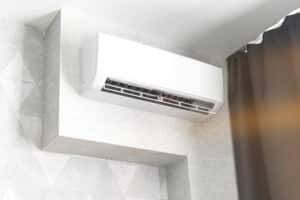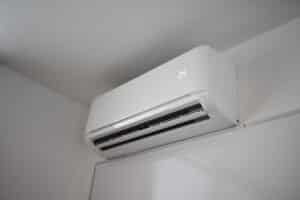Pros and Cons of Ductless Mini-Split ACs
If you live in San Francisco, CA, or elsewhere in the Bay Area, you may wonder which type of AC system is best for your home. One popular choice for many homeowners is a ductless mini-split AC. Like any other home comfort system, there are several important factors to consider before making the switch. The experts at TRIO Heating, Air & Plumbing have compiled some helpful ductless mini-split pros and cons to help you determine if this system is the right choice for you.

What Is a Ductless Mini-Split System?
A ductless mini-split system is just as the name implies: a ductless HVAC system that does not require any ductwork to operate. How does a ductless mini-split work? These home comfort systems include an outdoor unit (a condenser/compressor) and at least one indoor unit connected to refrigerant lines, usually run through a small hole in an exterior wall. This type of system is renowned for its exceptional energy efficiency and the ability to provide zoned cooling, offering greater control over temperature and energy usage in your home, making it one of the most energy-efficient air conditioning options available.
The Top Benefits of Mini-Split ACs
Here are some of the top mini-split AC benefits to consider:
- Excellent energy efficiency: Because mini-splits don’t use ductwork, they’re much more energy efficient and deliver treated air directly to individual rooms in your home, leading to significant energy savings.
- Zoned temperature control: Another of the many advantages of ductless mini-split systems is that they allow for individual temperature control in different rooms or zones, so you only need to heat or cool specific areas as needed.
- Quiet operation: These systems are well-known for having quiet operation that’s much less noisy than today’s traditional HVAC systems.
- Easy to install: A ductless mini-split installation is significantly easier than a traditional installation, as it requires no ductwork.
- Space-saving: Mini-split systems are compact and small, freeing up space and providing an effective home comfort system without occupying a lot of room.
Potential Drawbacks of Going Ductless
As you ponder whether a ductless AC is worth it, it’s important to consider the potential drawbacks of choosing this system for your home.
- Higher upfront costs: Mini-splits tend to be more expensive upfront to install than traditional HVAC systems, especially when multiple indoor units are chosen.
- Aesthetic concerns: Although they are small and compact, mini-splits are typically mounted on the wall or ceiling, which may not be a desirable feature for all customers to have inside their homes.
- Performance limits: A mini-split system works effectively in both warm and cold climates, but it may experience some performance limitations in areas with extreme temperature fluctuations.
- Maintenance needs: Routine ductless mini-split maintenance requires regular air filter changes for every indoor unit, and drainage issues may lead to serious water damage if not caught promptly.
Mini-Split vs. Central Air: Key Differences
Here are some of the key differences between a mini-split vs. central air:
- Central air provides whole-home cooling, while a mini-split system only treats the air in specific rooms where the indoor units are installed.
- Installing central air typically costs less money upfront, unless extensive ductwork repairs or new duct installations are required.
- Having a mini-split system reduces airflow issues and air loss, as a significant amount of air is lost through cracks, gaps, and improperly installed ductwork in traditional central air systems.

Who Should (and Shouldn’t) Choose a Ductless System
Before deciding if this is the right type of system for you, consider who should and shouldn’t choose a ductless system.
Who Should Choose Ductless
- People who live in smaller homes that don’t have a lot of square footage
- Those in older homes where installing new ductwork is required for traditional central air
- Homeowners who are concerned about energy efficiency and energy costs
- Anyone who prefers a quiet system that offers zoned heating and cooling control
Who Shouldn’t Choose Ductless
- People living in larger homes that require more consistent, whole-home cooling and heating
- Those who live in areas with extreme temperatures, and therefore need a more powerful system
- Homeowners who don’t like the idea of visible units in different rooms
- People who live in homes with existing ductwork and want to pay a lower upfront cost
Common Misconceptions About Ductless HVAC
There are a few common misconceptions about ductless HVAC systems. Some think they’re only suitable for small homes, but mini-splits work well if you use certain rooms more often and don’t mind visible units. Others believe they’re noisy or expensive to maintain, but they’re quieter than traditional systems and have fewer moving parts, leading to less frequent and less costly repairs.
Energy Efficiency and Cost Savings Over Time
The best ductless AC units should be appropriately sized for your home, have a high SEER rating, and be manufactured by a reliable brand. Installing a ductless mini-split system helps you save on energy and other home comfort costs over time.
- No duct losses: Ductless systems prevent energy loss caused by leaky ductwork in traditional HVAC setups.
- Zoned control: Cool or heat specific rooms as needed to reduce energy use.
- High efficiency: Mini-splits offer high SEER ratings for better energy performance.
- Lower long-term costs: Higher upfront costs are offset by monthly energy savings.

Talk to TRIO Heating, Air & Plumbing for a Professional Recommendation
TRIO Heating, Air & Plumbing is a trusted HVAC expert in energy-efficient and modern AC solutions for your Greater San Francisco Bay Area home. Whether you want to upgrade your current system or you’re building a new home, we have a variety of options available to you. To get expert recommendations on whether a ductless mini-split is the right solution for your cooling and heating needs, contact us today!
